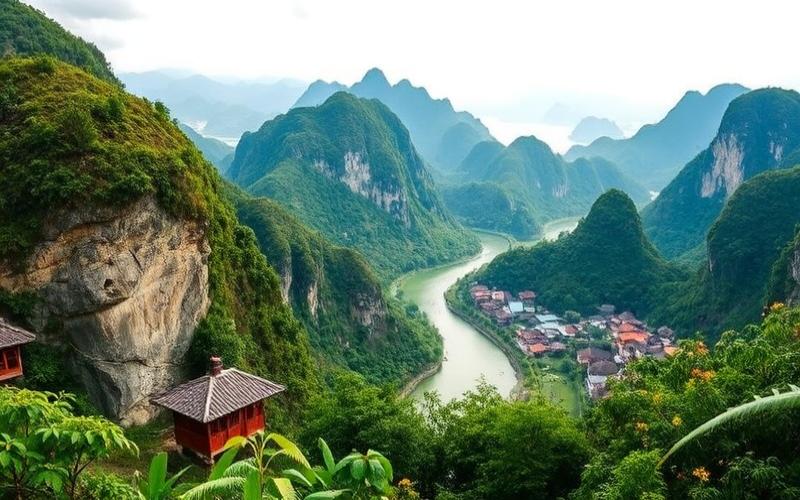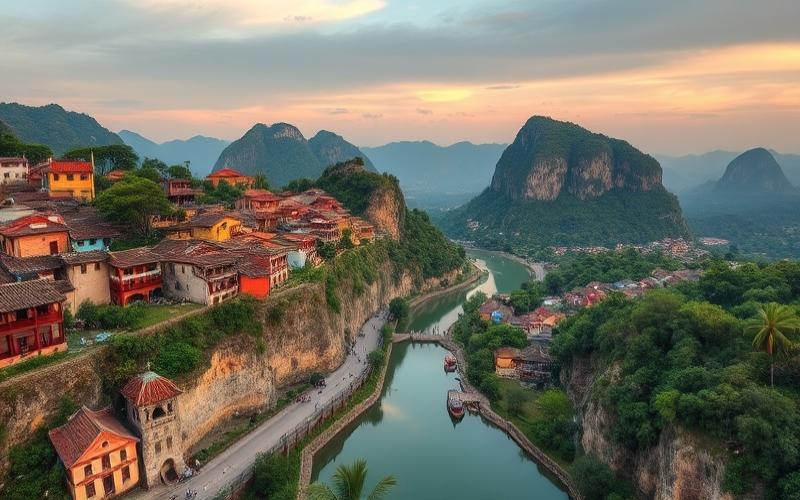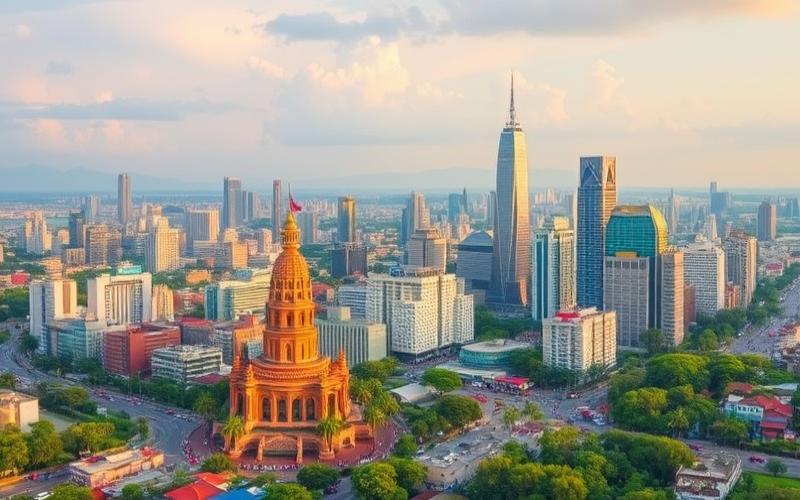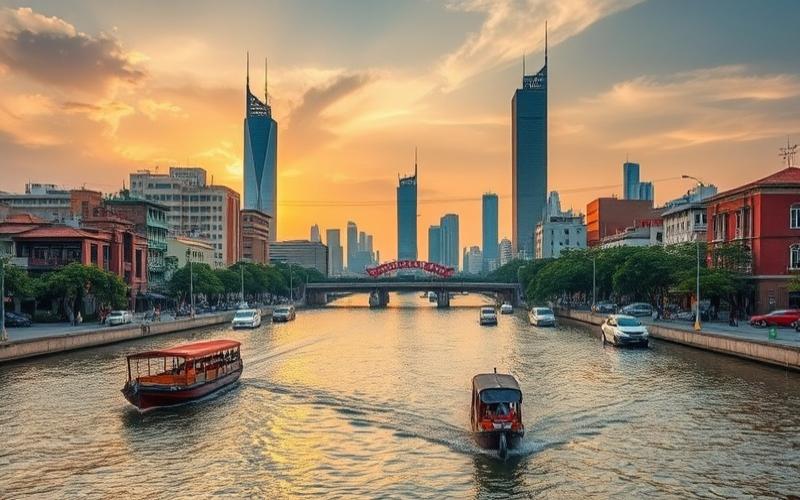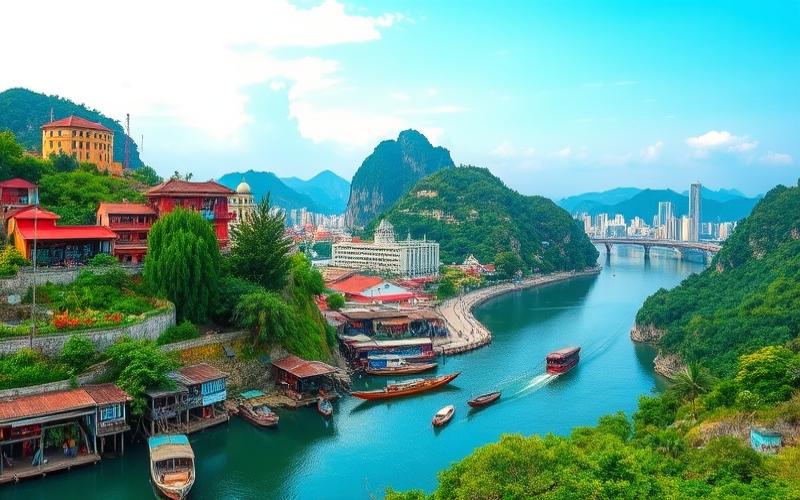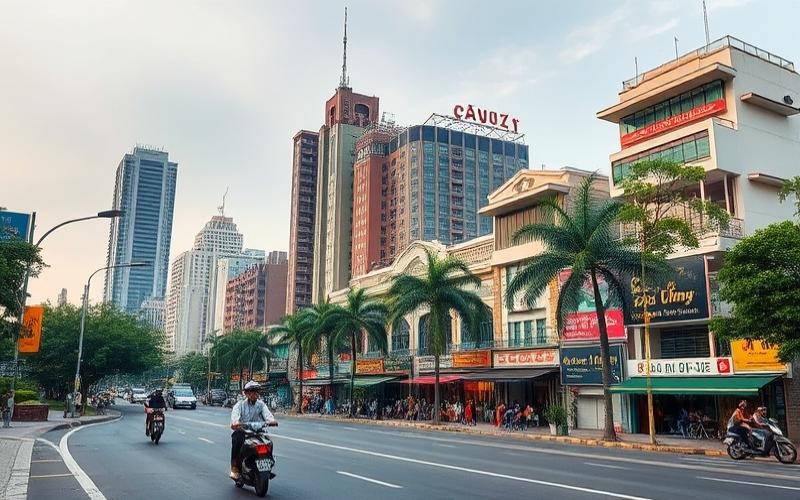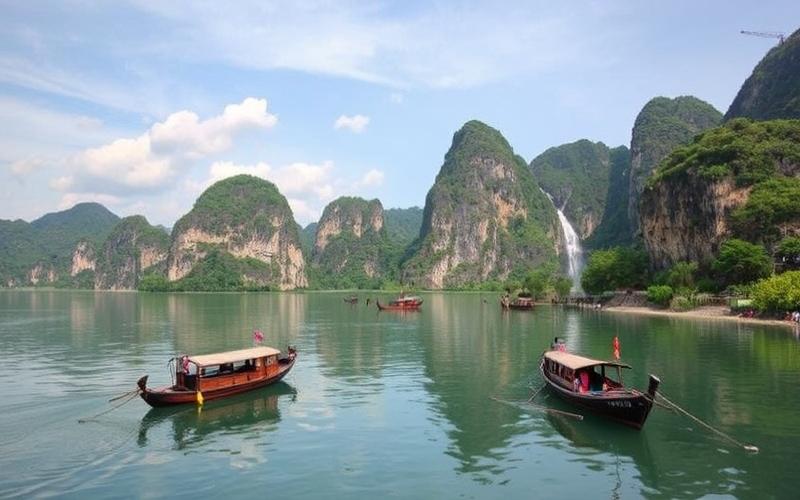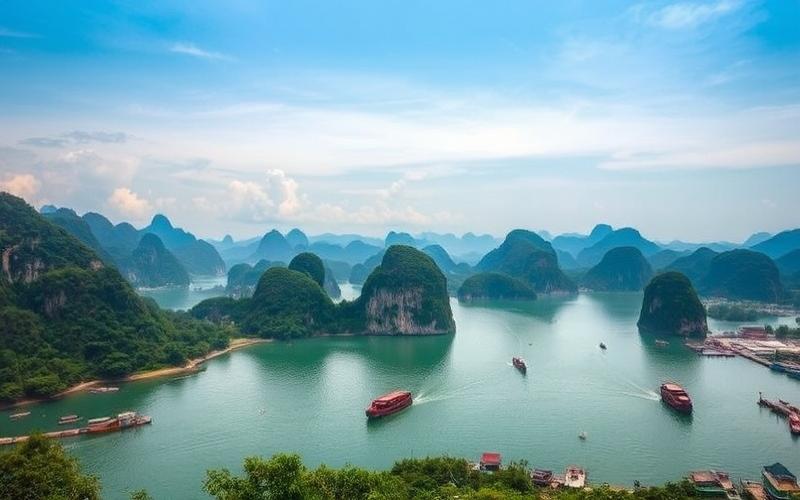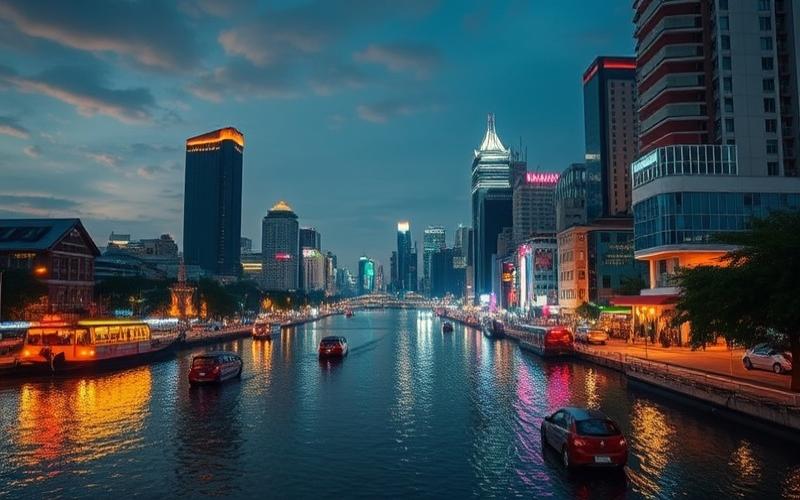
 Published on and written by Cyril Jarnias
Published on and written by Cyril Jarnias
Vietnam’s Real Estate Market Undergoing Transformation
In recent years, Vietnam has experienced rapid economic transformation, leading to significant fluctuations in the real estate market.
From Hanoi to Ho Chi Minh City, through emerging cities like Da Nang and Nha Trang, real estate prices vary considerably.
Factors Influencing the Real Estate Market
These variations are influenced by various factors such as:
- Increasing urbanization
- Demand from foreign investors
- Government policies
A Crucial Question
This dynamic context raises a crucial question: what is the impact of these variables on the country’s real estate landscape?
Good to Know:
Cities like Da Nang and Nha Trang are attracting more and more investors thanks to their tourism potential and attractive living environment.
Analysis of Price Disparities
In this article, we provide a detailed analysis of price disparities between these urban centers, offering essential insights for:
- Investors
- Researchers
- Observers of the Vietnamese market
Analysis of Real Estate Price Gaps Between Hanoi and Ho Chi Minh City
Real estate price gaps between Hanoi and Ho Chi Minh City result from a combination of economic, demographic, and geographic factors, as well as differences in urban development and infrastructure.
Economic Factors
- Ho Chi Minh City is the country’s main economic center, concentrating corporate headquarters, strong industrial activity, and significant foreign investment volume.
- Hanoi, although the political and administrative capital, experiences sustained growth linked to the implementation of new land laws (Land Law 2024) that have stimulated local demand.
Recent Data on Average Prices Per Square Meter (Q1-Q2 2025)
| City | Average Apartment Price ($/m²) | Annual Change (%) |
| Hanoi | 2,865 | +29.6 |
| Ho Chi Minh City | 2,800 | +6 |
- In Hanoi: strong annual increase thanks to legislative reforms.
- In Ho Chi Minh City: moderate but steady price progression.
Compared Market Segments
| Segment | Hanoi – Indicative Price (USD/m²) | HCMC – Indicative Price (USD/m²) |
| Apartment | ~2,865 | ~2,800 |
| Single-family home/villa | Generally above 3,000 | Around 3,200–5,000+ |
| Vacant land | Highly variable by location | More expensive in central districts |
- Villas/single-family homes are generally more expensive in Ho Chi Minh City due to land scarcity in central districts.
- Vacant land shows significant gaps depending on proximity to the center or potential for future urban development.
Demographic Factors
Dense population in both cities (~9 million for HCMC; ~8 million for Hanoi), but greater internal migration flows toward Ho Chi Minh City attracted by private employment.
Different family structure: in Hanoi a significant portion of real estate purchases comes from young families or local investors; in HCMC more purchases by institutional or foreign investors.
Geographic Factors
Ho Chi Minh City benefits from a strategic position for regional commerce with a major port open to Southeast Asia.
Hanoi, located in the north near Chinese borders, attracts more industrial investment related to cross-border logistics chains.
Urban Development & Infrastructure
- Massive deployment of road infrastructure around Ho Chi Minh City facilitating the creation of attractive peripheral residential hubs for the rising middle class.
- Accelerated modernization of the metropolitan network in Hanoi since 2024 (efficient public transport), which contributed to the rapid rebound in sales in some previously less sought-after neighborhoods.
Current Trends and Forecasts
Recent Evolution:
- After a notable surge in 2024 (+30% in some segments), stabilization or even slight correction observed in early 2025. Access to credit remains limited despite some favorable government measures.
- Overall level remains high compared to national average incomes: price-to-annual income ratio between 2.4 (Hanoi) and 2.7 (HCMC).
Forecasts:
- Anticipation of continued tension in the medium term given the chronic deficit between affordable new supply and growing urban demand.
- Continued public investment in metropolitan infrastructure could mainly support peripheral values rather than in the historic center where saturation limits any additional surge.
Political Role & Foreign Investments:
New land legislation effective early 2025 encourages transparency and legal security for private and institutional investors. This particularly strengthens attractiveness to Korean, Japanese, or Singaporean investors already heavily present in these markets for several years.
Key Takeaway: Gaps persist mainly due to the specific economic dynamism of each city, combined with their distinct strategies regarding urban infrastructure. While Hanoi saw prices jump recently thanks to new national real estate laws, Ho Chi Minh City maintains its historical premium due to its dominant economic status and appeal to foreign capital—particularly for high-end individual properties.
Good to Know:
Real estate prices in Hanoi average $1,700/m², compared to $2,200/m² in Ho Chi Minh City, a difference partly due to the faster economic dynamics and significant foreign investments in the latter. Ho Chi Minh City, as Vietnam’s economic center, benefits from advanced urbanization and better infrastructure, thus attracting more businesses and expatriates, which stimulates real estate demand, especially in apartment and single-family home segments. In Hanoi, although urban development is expanding, the pace is more moderate, influencing prices downward. Vacant land follows a similar trend, with costs generally higher in Ho Chi Minh City due to land scarcity. Recent government policies seek to balance growth between the two cities by encouraging public investment in Hanoi, but the medium-term market is expected to continue growing faster in the south.
Cost Per Square Meter in Da Nang and Other Emerging Cities
| City | Average Price per m² (2025) | Notable Neighborhoods/Projects | Trends and Influential Factors |
|---|---|---|---|
| Da Nang | €1,748 (downtown) 58 to 102 million VND/m² (premium waterfront) | My Khe, Vo Nguyen Giap, À La Carte Da Nang | Post-pandemic recovery, coastal increase, tourism attractiveness, political stability, exchange rate impact |
| Nha Trang | ~€1,700 to €2,000/m² (urban area) | Tran Phu, Vinh Hoa, resort projects | Strong tourism demand, foreign investments, hotel projects, fluctuation according to seasonal supply |
| Can Tho | €1,200 to €1,400/m² (urban area) | Downtown, Cai Rang, Hung Phu | Lower tourism attractiveness, logistics development, dominant local residential market |
Detailed Cost Analysis in Da Nang
- Average price per m² downtown:
€1,748 or approximately 48 to 60 million VND.
Premium waterfront projects (e.g., À La Carte Da Nang, My Khe – Vo Nguyen Giap) reach 58 to 102 million VND/m² depending on floor, view, and surface area. - Recent evolution:
Since 2024, Da Nang shows signs of recovery, particularly in the beach residence market and long-term programs. Prices in local currency are relatively stable; in euros, they fluctuate based on the dong exchange rate. - Neighborhoods with significant variation:
- My Khe / Vo Nguyen Giap: +20 to +30% over two years, driven by international demand and domestic investors.
- Traditional downtown: More moderate growth, but strong stability.
- Suburbs (Cam Le, Hoa Xuan): Lower prices (€1,200 to €1,400/m²), but catch-up dynamic with urbanization.
Comparison with Nha Trang and Can Tho
- Nha Trang:
Prices similar to Da Nang for downtown and beach projects, but more volatility due to strong tourist seasonality. New resort and hotel complex projects on the city’s north and south coast continue to drive prices upward, particularly in Tran Phu and Vinh Hoa neighborhoods. - Can Tho:
More accessible prices, market more oriented toward local population and logistics/residential development. Infrastructure projects (roads, river port) could support moderate price increases, but lack of strong tourism attractiveness limits surges.
Local and International Economic Factors
- Local:
- Post-pandemic tourism recovery
- Structuring urban projects (bridges, airports, new residential complexes)
- Growing demand from urban Vietnamese and diaspora
- International:
- Return of foreign investors, particularly Korean and Singaporean
- Dong fluctuation against euro or dollar, impacting prices for expatriates and foreign investors
- Sensitivity to government policies on foreign ownership
Investment Outlook and Projections
- Da Nang remains very attractive for tourist rental investment and medium-term appreciation, particularly on the waterfront (My Khe, Vo Nguyen Giap).
- Prices should continue to progress, but at a more moderate pace (3 to 6% per year), barring major economic or geopolitical shock.
- Peripheral areas offer superior growth potential thanks to urbanization and demographic pressure.
- Nha Trang will benefit from tourism offer diversification and new hotel projects, but possible medium-term saturation could slow price growth.
- Can Tho is worth monitoring for long-term positioning, particularly in residential and logistics segments, with lower volatility but stable rental yield.
Summary of Key Da Nang Neighborhoods to Watch:
- My Khe / Vo Nguyen Giap: Waterfront, premium, strong rental demand
- Downtown (Hai Chau, Son Tra): Stability, administrative proximity
- Suburbs (Hoa Xuan, Cam Le): Entry prices, appreciation potential
2025-2027 Outlook:
Da Nang and Nha Trang should maintain their status as emerging markets, driven by tourism, infrastructure, and foreign investor interest. Can Tho offers interesting diversification for a long-term portfolio oriented toward rental yield and low volatility.
Good to Know:
In Da Nang, the cost per square meter remains attractive, especially when compared to Nha Trang and Can Tho, two other emerging Vietnamese cities. Prices average around $1,500 to $2,000/m² in neighborhoods like My An and Son Tra, where tourism enthusiasm boosts demand. In Nha Trang, prices are slightly higher due to its strong tourism potential, reaching up to $2,500/m². Can Tho, however, offers lower prices, around $1,000/m², reflecting a slower but promising developing market. Factors influencing these fluctuations include infrastructure boom, rapid urban development, and growing interest from foreign investors. Ongoing projects like the Hi-tech Park in Da Nang could drive prices upward in coming years, making current investment particularly attractive. In comparison, Nha Trang gains popularity through its beaches, while Can Tho benefits from transport infrastructure improvements.
Future Trends of Vietnam’s Real Estate Market
Macroeconomic Factors Influencing the Real Estate Market
- National economic growth:
- Vietnam shows robust GDP growth, estimated at 6.8% in 2025 and targeted above 8% for following years. This dynamic is driven by exports, increased public investment, and real estate market recovery.
- Authorities are betting on structural reforms and accelerated infrastructure investments to support this expansion.
- Government real estate policies:
- Coherent development strategy focused on institutional reform, facilitation of real estate projects through administrative streamlining, and support for private and foreign investment.
- Planned acceleration of project approvals and strengthening of the financial sector to stabilize the market.
- Foreign investments:
- FDI flows remain stable around $25 billion USD per year. Real estate remains an attractive sector thanks to pro-investment policies and increasing integration into global chains.
Real Estate Demand and Supply Forecasts (2025-2030)
| City | Main Demand | Anticipated Supply | Key Factors |
|---|---|---|---|
| Hanoi | Residential & Offices | Strong | Rapid urban growth |
| Ho Chi Minh City | Residential & Industrial | Strong but under pressure* | National economic hub |
| Da Nang | Tourism & Residential | Moderate rising | Tourism & logistics development |
Potential Infrastructure Impact
- Massive infrastructure deployment (urban metros in Hanoi/HCMC, North-South highways).
- Creation or extension of special economic zones (SEZs) promoting industrial/logistics establishment.
- Significant improvement in land accessibility in urban periphery; likely upward effect on prices near new major axes/stations.
Expected Effects:
- Localized but marked price increases where modern transport or SEZs concentrate.
- Overall increase in attractiveness level for domestic/international investors.
Demographic Trends/Internal Migrations
List – Main Implications:
- Progressive demographic aging: expected rise for senior residences/integrated health services in some urban areas.
- Continuous urbanization: internal migration flows toward large cities maintain pressure on affordable housing (small units/collective apartments).
- Emergence of a young middle class: increased search for modernized/green/digitized properties particularly around educational or technological hubs.
Future Comparative Influence on Real Estate Prices Between Cities
Within five years,
– Ho Chi Minh City should maintain among the highest prices, driven by its economic engine status but also limited by central land scarcity despite rapid peripheral development.
– Hanoi will see its gaps with Ho Chi Minh City slightly reduce, thanks to an infrastructure boom accelerating its residential/commercial competitiveness.
– Da Nang will still show moderate progression, but will benefit from a strategic tourism-logistics positioning that could energize some specific segments without yet reaching the speculative level observed in the two major metropolises.
Structural evolutions related to internal migrations as well as demographic transformation should reinforce segmented demand: compact family housing near employment-education/health hubs in all large urban areas; high-end/senior residences gradually sought in well-served periphery or attractive coastal areas.
Good to Know:
Future trends of Vietnam’s real estate market could be influenced by several key macroeconomic factors. National economic growth remains solid, which could stimulate real estate demand, particularly in Hanoi and Ho Chi Minh City, where foreign investments continue to flow. Government policies favoring affordable housing construction and infrastructure development, such as transport network expansion and special economic zone creation, could increase accessibility and positively influence prices. Da Nang could see increased demand thanks to its rapid development. Internal migrations and demographic changes, notably with growing urban youth, should lead to increased demand for modern apartments in large cities. Comparatively, Ho Chi Minh City might experience more marked price increases than Hanoi and Da Nang due to its high concentration of infrastructure projects. These elements are essential to understand how real estate prices might differ between cities in coming years.
Disclaimer: The information provided on this website is for informational purposes only and does not constitute financial, legal, or professional advice. We encourage you to consult qualified experts before making any investment, real estate, or expatriation decisions. Although we strive to maintain up-to-date and accurate information, we do not guarantee the completeness, accuracy, or timeliness of the proposed content. As investment and expatriation involve risks, we disclaim any liability for potential losses or damages arising from the use of this site. Your use of this site confirms your acceptance of these terms and your understanding of the associated risks.




